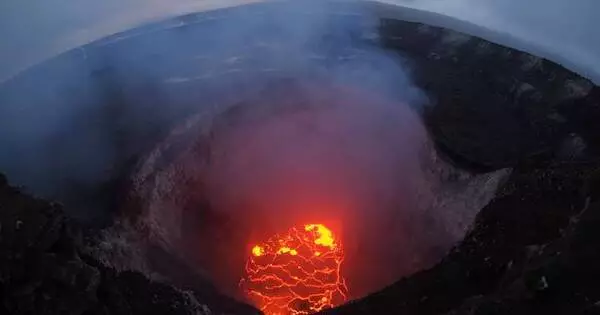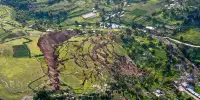Kilauea erupted slowly for ten years before exploding violently in 2018. New research sheds light on the volcano’s long-standing lava lake, which is one of the eruption’s features. A lava lake in Kilauea’s crater churned for ten years before the volcano let out a larger belch.
Kilauea erupted violently in 2018. Earthquakes, ash plumes, and lava flows disrupted life on Hawaii’s Big Island and altered the topography of the volcano. However, Kilauea had been slowly erupting for a decade prior to its big eruption. A persistent lake of lava formed inside the Halema’uma’u crater at Kilauea’s summit as a result of this slow-moving eruption.
University of Oregon earth scientists have discovered how the dynamics of this lava lake, as well as ground deformation around it, encode the signature of migrating volcanic gases and changing magma temperature in the volcano’s shallow plumbing system.
“It’s a fresh look at the dynamics of a well-known volcano,” says Leif Karlstrom, an earth scientist at the University of Oregon who led the research. “People could stand near the lava lake’s rim and look at the lava flows that were erupting. But there was a lot more going on beneath the surface.” Karlstrom and Josh Crozier, a former UO Ph.D. student who now works at the USGS California Volcano Observatory, published their findings in the journal Science Advances.
It’s a fresh look at the dynamics of a well-known volcano. People could stand near the lava lake’s rim and look at the lava flows that were erupting. But there was a lot more going on beneath the surface.
Leif Karlstrom
Kilauea’s lava lake was fed by a below-ground magma chamber, connected to the surface by a passageway. Since lava cools and solidifies fairly quickly, maintaining a consistent lava lake requires a remarkable balance: a steady influx of new lava from the depths, with enough lava leaving to prevent too much pressure from building up.
Researchers examined data collected by the Hawaiian Volcano Observatory from 2008 to 2018 to learn more about the volcano’s deeper dynamics. A network of sensors installed around the volcano monitors vibrations and other disturbances. “When something physically disturbs the magma chamber or the lava lake, it sloshes around, which we can measure with seismometers,” explains Josh Crozier, a former graduate student in Karlstrom’s lab. “We detected tens of thousands of such events during this decade-long eruption, and we’re combining this data with a physics-based model of the processes that generate these signals.”

The seismic signals observed around Kilauea summit encode the resonance of magma sloshing in and out of the shallow magma chamber, just as the sound of a fork tapping on a drinking glass changes depending on the amount of liquid in the glass or the sound of a drum changes depending on its shape. Unlike simpler musical instruments, the characteristics of this resonance are determined by both the shape and the properties of the magma, such as temperature and gas content. The researchers were able to deduce what was going on inside the volcano without directly probing the dangerous and extreme environment by carefully examining resonant signals throughout the eruption.
“Without any direct measurements, we can actually see gas building up over time and temperature changing,” Crozier says.
A simple model for effusive volcano eruptions such as at Kilauea says that magma gets pushed up from depth and spurts out of the volcano, like toothpaste squeezed out of a tube. But in the case of Kilauea’s 2018 eruption, “we don’t see any signs that there was a big magma influx leading up to eruption,” Crozier says. Instead, the new analysis supports the idea that shallow processes associated with draining of the summit magma chamber down the volcano’s east rift zone, helped shape the big eruption.
Karlstrom emphasizes that it is too early to use that information to forecast future eruption behavior. However, it may eventually aid scientists in making more informed interpretations of the volcano’s seismic signals. “The next step is to identify the implications of these variations we discovered for the dynamics and human hazards of the volcano.”
If you happen to be on the Big Island when one of the volcanoes is erupting, lava viewing is a must-do activity. Hawaii would not exist without the continuous volcanic activity that formed all of the islands, and witnessing this in “real-time” is a once-in-a-lifetime experience for many people.
















